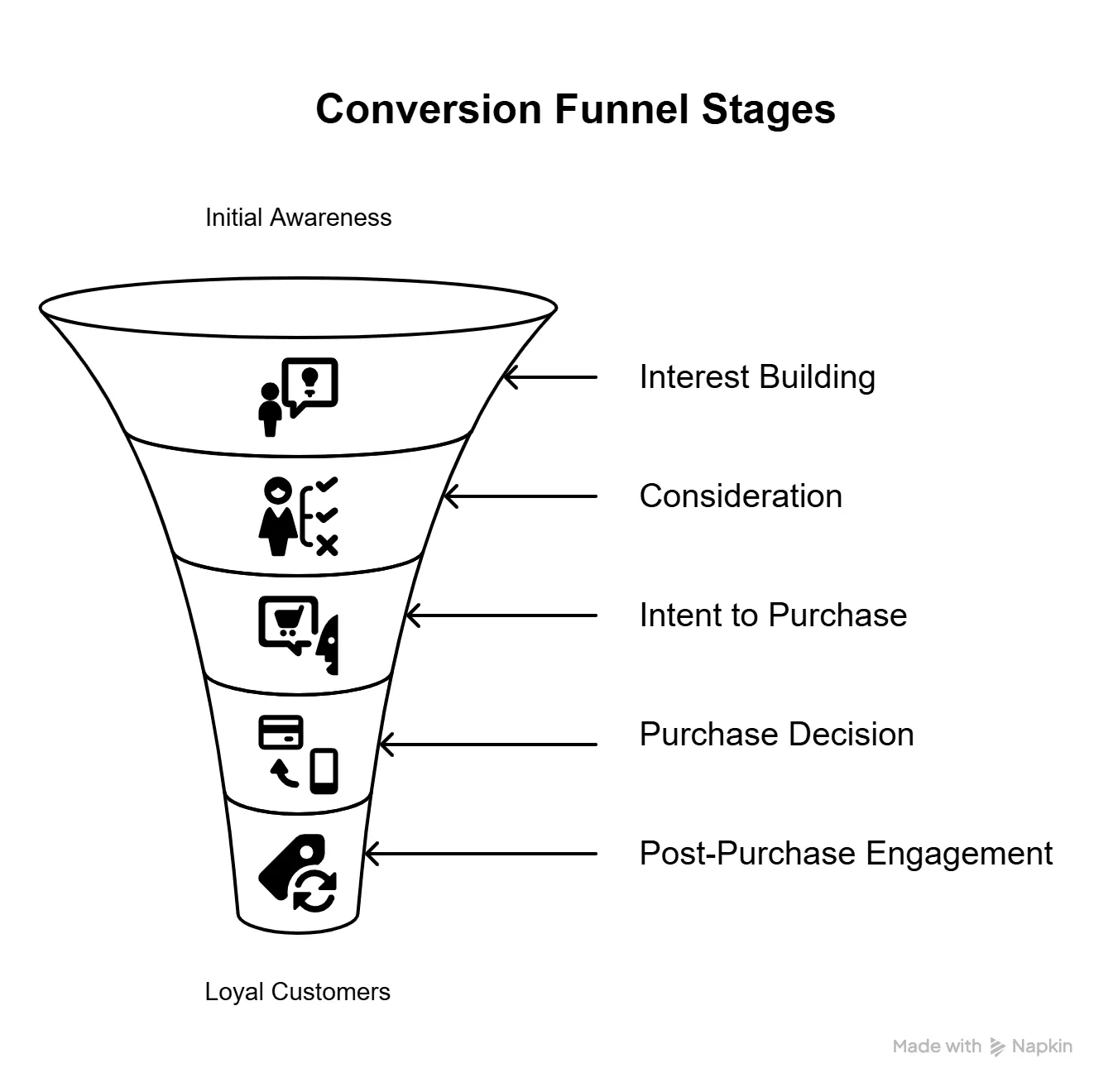Sales Funnel Fundamentals
How to Build a System That Actually Converts

If you're running a business without understanding what a sales funnel is, you're basically trying to catch water with a tennis racket.
A sales funnel isn't just some marketing buzzword that consultants throw around to sound smart – it's the difference between randomly throwing spaghetti at the wall and having a systematic approach to turning strangers into paying customers.
What the Heck is a Sales Funnel Anyway?
Picture this: You've got a regular kitchen funnel. Wide opening at the top, narrow spout at the bottom. That's your sales process in a nutshell.
The sales funnel is your strategic roadmap that maps out exactly how potential customers move from "Who are you?" to "Here's my credit card."
It's not rocket science, but it's methodical as hell. Every interaction, every touchpoint, every piece of content you create should be designed to move people from one stage to the next.
No random acts of marketing here – just purposeful, profit-driven progression.
The Anatomy of a Conversion Machine
Here's how this beautiful beast works, stage by stage:
Top of Funnel - Awareness Stage
This is where people first discover you exist. Could be through Google search, social media, word of mouth, or that billboard you splurged on.
The goal?
Get on their radar without being creepy about it. You're not trying to sell anything yet – you're just establishing that you're a real business that solves real problems.
Interest Stage - The Hook
Now they're paying attention. This is where you prove you're not just another company trying to separate them from their money. Share valuable insights, solve smaller problems for free, and demonstrate expertise. You're building trust and showing them you actually understand their world.
Consideration Stage - The Courtship
They're seriously evaluating whether you're the right fit. This is where prospects start comparing you to competitors, reading reviews, maybe even talking to your existing customers.
Your job is to make this process as easy as possible while highlighting what makes you different.
Intent Stage - Almost There
They're ready to buy something, but they might still be hesitating. This is where you address objections, offer guarantees, maybe throw in some urgency.
Offer free trials, consultations, detailed demos – whatever it takes to get them over the finish line.
Purchase Stage - The Money Moment
Ka-ching! They've decided to trust you with their hard-earned cash.
But here's the thing – your job isn't done. Make the buying process smooth, confirm they made the right choice, and set expectations for what happens next.
Post-Purchase Stage - The Goldmine
This is where most businesses completely drop the ball. Your existing customers are 5-25 times more likely to buy from you again than new prospects.
Keep them happy, offer upgrades, ask for referrals. One satisfied customer can become your best salesperson.

Why Your Business Absolutely Needs This System
Let me break down why having a sales funnel isn't optional anymore:
Lead Organization That Actually Makes Sense
Without a funnel, you're treating every prospect the same way. That's like using a sledgehammer to perform surgery.
With a proper funnel, you know exactly where each person is in their buying journey and can tailor your approach accordingly. Someone just learning about your industry needs different information than someone ready to purchase tomorrow.
Conversion Rates That Don't Suck
Industry data shows that companies with defined sales funnels see 18% higher conversion rates than those winging it.
When you optimize each stage, you're not just hoping for the best – you're systematically removing friction and addressing concerns before they become deal-breakers.
Customer Experience That Doesn't Drive People Away
A well-built funnel ensures people get the right information at the right time.
No overwhelming them with pricing when they're just browsing.
No generic content when they need specific solutions.
It's about meeting people where they are, not where you want them to be.
ROI That Actually Justifies Your Marketing Spend
Here's the brutal truth: 61% of B2B marketers struggle to measure ROI because they don't have proper funnel tracking.
When you can see exactly where prospects drop off and which activities drive the most revenue, you can double down on what works and kill what doesn't.
Insights That Change Everything
Your funnel becomes a goldmine of data. You'll discover which marketing channels bring in the highest-quality leads, which content pieces actually move the needle, and where your sales process needs work. It's like having a GPS for your revenue growth.
Scalability Without Chaos
As your business grows, a defined funnel lets you hire and train new team members without everything falling apart.
The process is documented, repeatable, and scalable. You're not dependent on one person's relationship-building skills or institutional knowledge.
Customer Lifetime Value That Keeps Giving
Studies show that increasing customer retention by just 5% can boost profits by 25-95%.
Your funnel doesn't end at the first purchase – it includes strategies for upselling, cross-selling, and turning customers into advocates who bring in new business.
Build A Sales Funnel Today
A sales funnel isn't just a nice-to-have framework – it's the foundation of sustainable business growth. Companies with mature lead generation and management practices generate 133% more revenue than those without.
In today's competitive landscape, where customers have endless options and attention spans measured in seconds, you can't afford to leave revenue on the table.
A well-designed sales funnel is your systematic approach to turning casual browsers into loyal customers who stick around and bring their friends.
The businesses that thrive aren't the ones with the best products or the biggest marketing budgets. They're the ones that understand their customers' journey and optimize every step of the process. That's what separates the companies that scale from the ones that struggle.
Stop hoping customers will magically find you and decide to buy. Build a funnel that guides them there instead.

